#Glycolic
Text
CMoss Beauty Skincare has fab products with collagen of the sea
These days so many companies are choosing to add unique ingredients into their skincare products. cMoss Beauty proclaims their nutrient-rich skincare as “collagen of the sea” skincare. It’s the unique ingredient in all of the products of cMoss Clean Beauty. I tested out three products from this “Collagen of the Sea” skincare brand.
So what is the cMOSS “Collagen of the Sea?” It’s a proprietary…
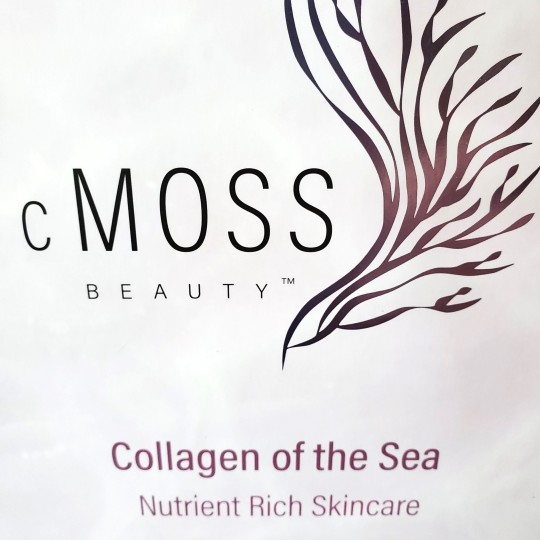
View On WordPress
#@beauty#ocean#amethyst#beautiful#beautifulman#beautifulwoman#chondruscrispus#cleanbeauty#cleanskin#crystals#florida#glycolic#health#irishseamoss#products#rangeme#seamoss#seamossskincare#sephora#ulta#youngliving
0 notes
Text
Is Glycolic Peeling Solution beneficial for Acne-prone skin?
Glycolic acid is a popular ingredient in many skincare products, particularly in chemical peels, due to its ability to exfoliate the skin and promote cell turnover. However, many people with acne-prone skin may wonder if glycolic peeling solutions are suitable for them. In this blog post, we will explore the benefits and potential drawbacks of using glycolic peeling solutions on acne-prone skin.
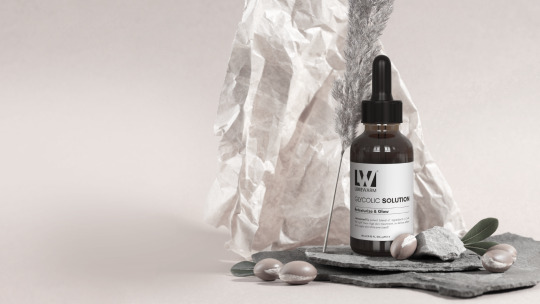
What is a Glycolic Peeling Solution?
Glycolic peeling solution is a type of chemical peel that contains glycolic acid as the active ingredient. It is a mild exfoliant that works by breaking down the bonds that hold dead skin cells together, revealing smoother, brighter, and clearer skin.
Lukewarm Glycolic Solution is the ultimate resurfacing treatment for increased radiance and clarity.
This supercharged treatment contains an impressive 34% AHA and 2% BHA blend of Glycolic, Lactic, and Salicylic acids, providing an exceptional combination of surface-level and deep exfoliation to stimulate cell regeneration for a brighter, more even appearance.
Benefits of Lukewarm Glycolic Peeling Solutions for Acne-Prone Skin:
Acne-prone skin is characterized by excess sebum production, clogged pores, and inflammation. Lukewarm Glycolic peel can help address these issues in the following ways:
Exfoliation: Glycolic acid removes dead skin cells and unclogs pores, lowering the chances of breakouts.
Oil Control: Glycolic acid also aids in the regulation of sebum production, which can minimize the possibility of developing new pimples.
Scar Treatment: It can help fade acne scars over time by stimulating collagen production and improving skin texture.
Brightening: Lukewarm Glycolic peeling solution can help brighten dull, acne-prone skin by removing the build-up of dead skin cells that can make the skin look dull.
Risks of Glycolic Peeling Solutions for Acne-Prone Skin :
While glycolic peeling solutions can be beneficial for acne-prone skin, there are also some potential risks to consider:
Irritation: Glycolic acid can cause redness, burning, and itching, particularly in sensitive skin types. It is essential to start with a lower concentration and patch test the product before applying it to the entire face.
Sun Sensitivity: Glycolic acid can increase sun sensitivity, making the skin more prone to sun damage. It is crucial to wear a broad-spectrum sunscreen with an SPF of at least 30 after using a glycolic peel.
Dryness: Glycolic acid can cause dryness and flakiness, particularly if used too frequently or at high concentrations. It is essential to follow the instructions carefully and avoid overuse.
Finally, glycolic peeling solutions can be a useful addition to the skincare routine of those with acne-prone skin because they promote exfoliation, control oil, treat scars, and brighten the complexion.
To avoid irritation, dryness, and hyper-pigmentation, use them with caution and begin with a lower concentration.
#glycolic#glycolic peel#pigmentation#acne#hyperpigmentation#dullskin#chemical peels#skincare routine#skincare tips#skincare#antiaging#acne prone skin#beauty tips#beauty#woman#face#skin lightening#dark spots#fine lines and wrinkles
0 notes
Text

SKINCARE REVIEW #002
Product Name: The Ordinary Glycolic Acid 7% Toning Solution
Rating: ♥ ♥
Price: ~700 PHP (~13 USD)
Review: I discovered this toner while I was idly scrolling through BeautyMNL, a local platform for beauty products (this isn't sponsored, but check it out here), right after I added the niacinamide serum from the same brand to my cart. This was during The Height™ of my skincare obsession—my teenage acne was all over my face, and I was desperate for a strong fix.
I became too desperate, I guess. I was blinded by the good reviews and didn't care to look at the bad ones until it was too late, when I was trying to find out if people were experiencing the same things I was. It stung in a way that wasn't completely unpleasant, but together with the slight stickiness, it got annoying fast.
Maybe my personal mistake was applying it to areas where my skin was particularly thin, such as the outer corners of my nose and the space just right below my lips. Unlike those Korean toners, this isn't the type you spread on your hands and pat on your face. This seemed like a medical-grade, dermatologist-prescribed type of toner. Actually, one of the other reasons why I gravitated towards this is because my dermatologist had given me a glycolic acid toner before, but maybe that had less of a concentration.
Glycolic acid is used, most often in low concentrations, for chemical exfoliation. Products with high concentrations often cause evident peeling on your skin. Basically, it gets rid of dead skin cells and speeds up the process of your skin cells' renewal. I might have to write about chemical vs. physical exfoliation one of these days and link it here, with references from experts.
Objectively, this toner is alright, but I guess it was too strong of a formulation for my sensitive skin, and I was new to all this skincare stuff. After a week of trying it out, I resorted to watering it down before applying it to my face, which kind of helped, because some of my angry acne dried out. But unlike the niacinamide serum, I discarded this (more like gave it to my younger sister who had a normal skin type) and never wanted to see it again.
I could have been a misguided teenager, so I really want others to take my opinion on this toner with a grain of salt. Let me know about your experience with this toner through the DMs or notes!
You can also check out my current skincare routine here!
#beauty#beauty products#beauty routine#beauty remedies#skincare#skincare routine#skincare tips#beauty tips#the ordinary#glycolic acid#glycolic#niacinamide#serum#face serum#toner#face toner#acne#acne treatment#skin care#pimples
1 note
·
View note
Text
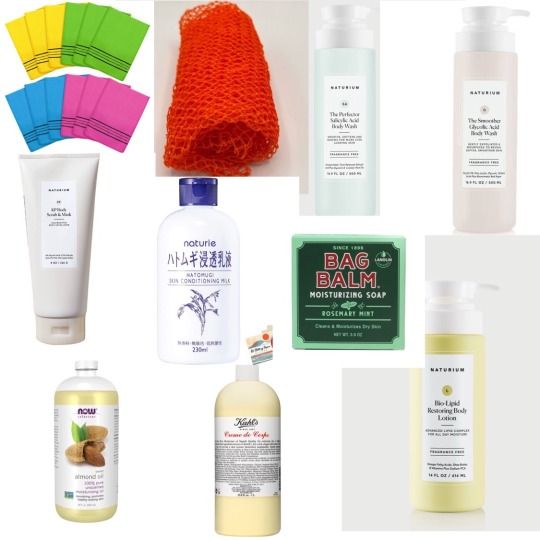
Releasing the night body routine that’s helping with kp. My texture is like 95% gone and once that’s done, were fixing the appearance but that’s further down the line 🫂 progress requires consistency
Double cleansing my body with any bar soap (i use bag balm) using an italy towel. Then i use an african net sponge and switch on and off between salicylic and glycolic acid body wash by naturium. Twice a week i use the kp scrub from the naturium, back of arms and legs only. This double cleanse is for non sensitive areas only. Then out the shower still damp I spray and rub in naturie skin conditioning milk. Then lotion, I like creme de corps or the naturium body lotion. After that I oil with sweet almond. I forgot to add it lol but once a week i do retinol lotion on my legs in place of regular lotion, i don’t oil legs on these nights. I only do this at night when i have the time lol
512 notes
·
View notes
Note
Hi my husband and I have never used lubrication but I have PCOS yes I did comment this on your post unanon but I don't want too much attention anyways we've used Vaseline like twice I'm wondering what works?
So first off: please please don’t use Vaseline inside a vagina. It’s one of the big three that uses a lot of glycerin, which is just not a good thing to introduce to the hardworking vaginal flora. The well known brands Vaseline, Astroglide, and KY are all big offenders on this front. It preserves lube and also makes it taste sweet which people like but vaginas really don’t.
I don't know specifically if lubrication will help with PCOS pain, but it's just a generally good idea for sex. And as an uninformed non-medical professional it does seem like more lube more better with regards to cysts but definitely consult a doctor! I'd check out Sliquid lube which has a nice thick consistency similar to Vaseline without the offending ingredient.
#ask ffs#I had several medical people who told me they recommended KY and then immediately stopped when I started preaching about the glycol#it's one of the shittier lubes on the market and they switched to recommending Earthly Bodies WaterSlide after learning more about it
61 notes
·
View notes
Text
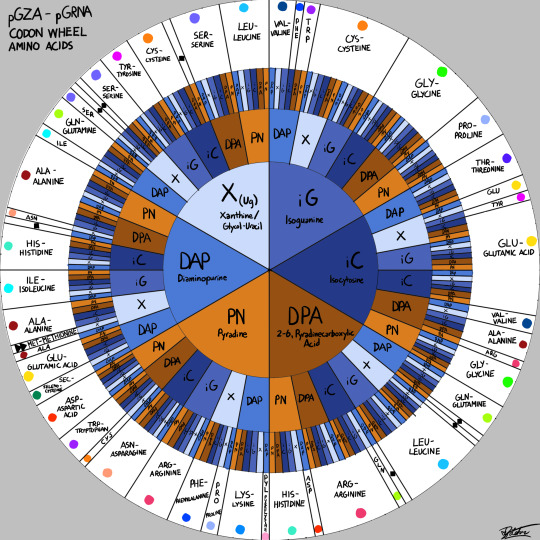
Codon Amino Acid chart for pGZA, the building block of life on Jom'Gol
pGZA is the abbreviation for Propylene-Glycol Nucleic Acid, which all cellular life on Jom'Gol uses. pGZA uses the sugar Propylene Glycol and a standard phosphate base.
Instead of Adenine, Thymine/(Uracil), Guanine, and Cytosine, pGZA instead uses Diaminopurine, Xanthine, Isoguanine, Isocytosine, 2-6, Pyradinedicarboxylic acid, and Pyradine.
Rather than (DNA):
A-T (Hydrogen Bond)
C-G (Hydrogen Bond)
pGZA uses:
DAP-X (Hydrogen Bond)
iC-iG (Hydrogen Bond)
PN-DPA (Copper ii ion Bond)
Each Codon combination in pGRNA production results in the production of one of 23 amino acids when read by the xenoribosome in any Jomgolian creature's cell, with the addition of one start codon and several stop codons.
#art#digital art#artists on tumblr#worldbuilding#speculative biology#speculative evolution#spec evo#spec bio#xenobiology#dna#jomgol#propylene glycol#xenonucleic acid
40 notes
·
View notes
Text
my allergies (? pending. might be smth else who knows at this point) have been acting up so bad lately in ways they haven't before and I'm Over It
#I have this fun reaction to propylene glycol (don't @ me if that's misspelled)#which is in virtually everything bc it's a preservative#and I get rashes from it#and I'm reacting like that on my face/around my eyes but To Nothing#like I haven't put anything but water or regular ass soap on my face why 😭
8 notes
·
View notes
Text
my fingerprints on the inside of the glass,
trapped within mountains of fake snow and
gravity, a curiosity on a shelf.
shake me, hurt me, watch me fall apart,
watch me rain until i no longer move / until
i bore you with my silence / my refusal to die .
pretty pictures painted / with blood on the
inside of the glass. warped words & missed
messages for a god whose place you have taken.
let me out, let me watch, let me bury myself
in white plastic & drown in anti freeze, let me
gather dust, safe from time, alone in the dark.
#alex writes#spilled ink#original poetry#y'know i was very disappointed to find out the snow in snow globe is literally just plastic#some water‚ some ethylene glycol and some glycerine and there you have it#boring but still a good metaphor
5 notes
·
View notes
Text
Tragic Lessons: The Elixir Sulfanilamide Incident and the Birth of Drug Safety Regulation

In 1937, the US-based Massengil pharmaceutical company's chemists developed a new sulfonamide oral preparation named "Elixir Sulfanilamide." At that time, there was no requirement for safety review before launching new drugs. Consequently, this untested drug went on sale in September of that year. In October, the American Medical Association received reports of fatalities caused by the medication.

In November, the US Food and Drug Administration (FDA) intervened, recalling the drug. The investigation found that "ethylene glycol," used as a solvent in the drug, was the main culprit of poisoning. Ethylene glycol is highly toxic to mammals, with a minimum lethal dose (LD₅₀) of 786 mg/kg in humans. This issue, easily detectable through a simple animal experiment, resulted in over 100 deaths that fall, with 30% being children.
The following year, under immense public pressure, the US Congress passed the landmark "Federal Food, Drug, and Cosmetic Act" (FFDCA), mandating safety reviews for all new drugs before market approval and granting the FDA regulatory oversight authority.
#fda#us fda#drug safety#drug#ethylene glycol#chemblr#stemblr#science#molecule#chemistry#kingdraw#incidence#toxicity
5 notes
·
View notes
Text
Ethylene glycol (see figure 19.2) and propylene glycol are synthesised from ethylene (ethene) and propylene (propene) respectively, hence their common names as shown below.
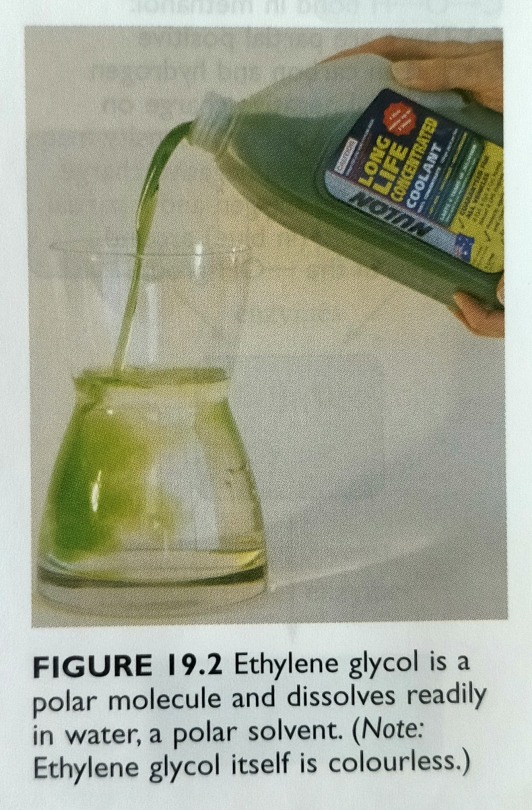

"Chemistry" 2e - Blackman, A., Bottle, S., Schmid, S., Mocerino, M., Wille, U.
#book quotes#chemistry#nonfiction#textbook#ethylene glycol#propylene glycol#ethylene#ethene#propylene#propene#synthesis#polarity#ethane#propane
4 notes
·
View notes
Text
i hate that almost every skincare product for oily skin has niacinamide in it...like it doesn't do anything for me and i find it actually makes my skin look worse 😭
2 notes
·
View notes
Text
the one thing about me is that you can explain photosynthesis to me a million times every single day of my life for the next 70 years until I'm dead and it still will never "click" in my brain
#I have constantly been learning photosynthesis for like the past 5ish years and#every time it comes up in a class it's like the first time I'm hearing about it#like I know HOW it works its just once you start talking about glycolate and RuBP and 3-PGA and all that...#I need to relearn this shit from scratch each time lol
4 notes
·
View notes
Text
Defoamers in Wastewater Treatment - Mitigating Foam and Improving Processes
In the realm of wastewater treatment, foam can be a persistent nuisance, hindering efficiency and complicating operations. From excessive foaming in aeration tanks to foam buildup in clarifiers and digesters, foam-related issues can lead to process disruptions, increased maintenance costs, and compromised treatment performance. Fortunately, defoamers offer a practical solution for mitigating foam and improving processes in wastewater treatment plants. In this comprehensive guide, we explore the role of defoamers in wastewater treatment, their benefits, and the different types available from leading manufacturers in India.

Understanding Foam Formation in Wastewater Treatment
Foam formation in wastewater treatment processes can occur due to various factors, including:
Organic Matter: The presence of organic compounds in wastewater, such as proteins, fats, and surfactants, can contribute to foam formation by stabilizing air bubbles and increasing surface tension.
Microbial Activity: Microorganisms present in wastewater can produce extracellular polymeric substances (EPS) that promote foam stability and persistence.
Mechanical Agitation: Agitation caused by aeration, mixing, or pumping can introduce air into the wastewater, leading to foam formation.
Chemical Reactions: Certain chemical reactions, such as the release of gases during anaerobic digestion, can result in foam generation.
The Role of Defoamers in Wastewater Treatment
Defoamers, also known as antifoaming agents, are chemical additives designed to disrupt foam formation and promote foam collapse in wastewater treatment processes. By reducing surface tension and destabilizing foam bubbles, defoamers help prevent foam buildup and facilitate the smooth operation of treatment units. Some common applications of defoamers in wastewater treatment include:
Aeration tanks
Clarifiers and thickeners
Digesters
Filtration systems
Sludge dewatering processes
Types of Defoamers
Defoamers used in wastewater treatment are available in various formulations, each suited to specific applications and operating conditions. Some of the most common types of defoamers manufactured in India include:
Silicone-Based Defoamers:
Silicone-based defoamers are widely used in wastewater treatment due to their excellent foam-suppressing properties and chemical stability. These defoamers are effective across a wide pH range and can withstand high temperatures, making them suitable for diverse wastewater treatment applications.
Alcohol-Based Defoamers:
Alcohol-based defoamers contain alcohol compounds that disrupt foam formation and promote bubble coalescence. These defoamers are often used in wastewater treatment processes where silicone-based formulations may not be suitable due to compatibility issues with certain chemicals or materials.
Glycol-Based Defoamers:
Glycol-based defoamers utilize glycol compounds to combat foam formation in wastewater treatment. These defoamers are known for their fast-acting properties and low toxicity, making them suitable for use in environmentally sensitive applications.
Benefits of Using Defoamers in Wastewater Treatment
Improved Process Efficiency: By reducing foam buildup and preventing process disruptions, defoamers help wastewater treatment plants maintain optimal process efficiency and throughput.
Cost Savings: Defoamers help minimize downtime, reduce maintenance requirements, and enhance the performance of treatment equipment, resulting in cost savings for wastewater treatment plants.
Enhanced Treatment Performance: By mitigating foam-related issues, defoamers enable wastewater treatment plants to achieve better treatment outcomes, including improved effluent quality and compliance with regulatory standards.
Versatility: Defoamers are available in various formulations to suit different wastewater treatment applications, ensuring versatility and adaptability to specific process requirements.
Choosing the Right Defoamer Manufacturer in India
When selecting a defoamer manufacturer in India, it's essential to consider factors such as product quality, technical support, and reliability. Look for a manufacturer with a proven track record of supplying high-quality defoamers for wastewater treatment applications. Additionally, ensure that the manufacturer offers comprehensive technical support and assistance to help you select the right defoamer for your specific needs.
Imperial Oilfield Chemicals Pvt. Ltd. (ICPL) – Your Trusted Defoamer Manufacturer in India
As a leading manufacturer of specialty chemicals in India, Imperial Oilfield Chemicals Pvt. Ltd. (ICPL) offers a wide range of defoamers specifically designed for wastewater treatment applications. Our silicone-based, alcohol-based, and glycol-based defoamers are formulated to deliver exceptional performance, reliability, and cost-effectiveness.
With decades of experience in the chemical industry and a commitment to innovation and quality, ICPL is your trusted partner for all your defoamer needs. Whether you're operating a municipal wastewater treatment plant, an industrial wastewater facility, or a specialized treatment unit, we have the expertise and resources to provide customized defoamer solutions tailored to your requirements.
Conclusion
In conclusion, defoamers play a crucial role in mitigating foam and improving processes in wastewater treatment plants. Whether it's silicone-based, alcohol-based, or glycol-based formulations, defoamers offer effective solutions for combating foam-related issues and enhancing the efficiency and performance of treatment operations. By choosing the right defoamer manufacturer in India, Imperial Oilfield Chemicals Pvt. Ltd. (ICPL), wastewater treatment plants can benefit from high-quality defoamers and comprehensive technical support to meet their foam control needs effectively.
#Glycol Based Defoamer Manufacturer in India#Alcohol Based Defoamer Manufacturer in India#Defoamer Manufacturer in India#Silicone Based Defoamer Manufacturer in India
3 notes
·
View notes
Photo
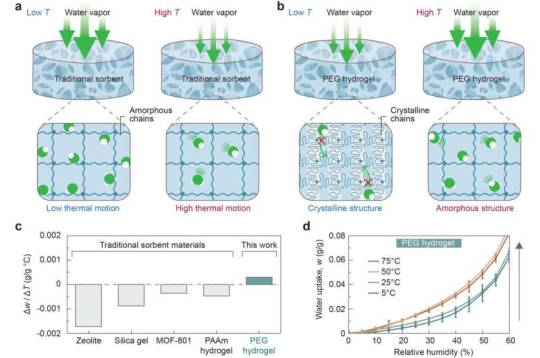
Even as temperatures rise, this hydrogel material keeps absorbing moisture
The vast majority of absorbent materials will lose their ability to retain water as temperatures rise. This is why our skin starts to sweat and why plants dry out in the heat. Even materials that are designed to soak up moisture, such as the silica gel packs in consumer packaging, will lose their sponge-like properties as their environment heats up.
But one material appears to uniquely resist heat's drying effects. MIT engineers have now found that polyethylene glycol (PEG)—a hydrogel commonly used in cosmetic creams, industrial coatings, and pharmaceutical capsules—can absorb moisture from the atmosphere even as temperatures climb.
The material doubles its water absorption as temperatures climb from 25 to 50 degrees Celsius (77 to 122 degrees Fahrenheit), the team reports.
PEG's resilience stems from a heat-triggering transformation. As its surroundings heat up, the hydrogel's microstructure morphs from a crystal to a less organized "amorphous" phase, which enhances the material's ability to capture water.
Read more.
#Materials Science#Science#Hydrogels#Absorption#Water#Polyethylene glycol#Temperature#Water harvesting#MIT
13 notes
·
View notes
Text

my unbeatable skincare routine. poses cutely
#i only got the cream recently ive been using vaseline body lotion on my face for years😭😭😭#the moisturizer and cream were on sale…#girl theres so much fucking glycolic acid in that bottle im gonna take 10 whole years to finish it IVE BEEN USING IT TWICE A WEEK#FOR TWO YEARS#AND IM NOT EVEN HALFWAY😭😭😭😭#so i give my friend some in a bottle too
4 notes
·
View notes
Text

#to the East African man outside a random pub 2nite NEVER pull that shit again we are literally from the same place and your surprised i#have good skin? I don’t believe it#two huruud masks glycolic acid vit c drugstore moisturiser tea tree oil or some hydrocortisone cream would give this man the same exact glow#but EEEEYE had to be late to the fuction for him to marvel at our SHARED complexion#you know that lady that goes HOOOOOooo in the tiktok? that was me
8 notes
·
View notes